Russia’s destruction of the dam of the Kakhovka hydropower plant has been called the largest technogenic catastrophe since the explosion of the Chornobyl nuclear power plant in 1986. The unleashed flood has killed at least 21 people on Ukrainian-controlled territory, with the victim toll expected to be in the hundreds in Russia-occupied Ukraine. 600 square kilometers were flooded, including 77 settlements. Thousands of homes are no longer habitable. People are in need of shelter, food, water, money.
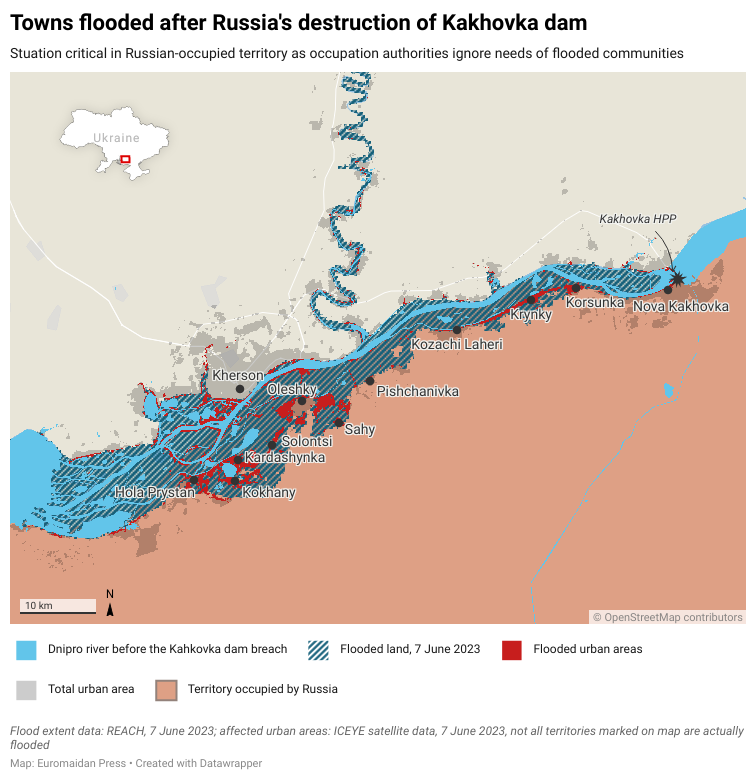
However, beyond the pressing humanitarian concerns are the tremendous changes to Ukraine’s economy and environment. Once, the construction of the Kakhovka water reservoir transformed Ukraine’s arid south-east into the “grain basket of Europe”; now, Ukraine will need to grapple with not only irrigation challenges but simply providing water to millions of residents.
1. Water contamination and sea pollution
Despite the abundance of water that flooded at least 4,000 houses, thousands of Ukrainians now face a drinking water crisis. According to the international crisis analysis group REACH, 465,000 tons of transformer oil from the Kakhovka Hydroelectric Power Plant ended up in the floodwaters; additionally, 54 oil facilities and 24 hazardous industrial facilities, hosting ammonia, antibiotics, biodiesel, chlorine, isopropyl alcohol, kerosene, oils and solvents, and various petroleum products, were impacted by the flood. REACH also identified 18 biohazardous sites such as cemeteries and landfills, that were flooded and thus potentially released their hazardous substances into groundwater.
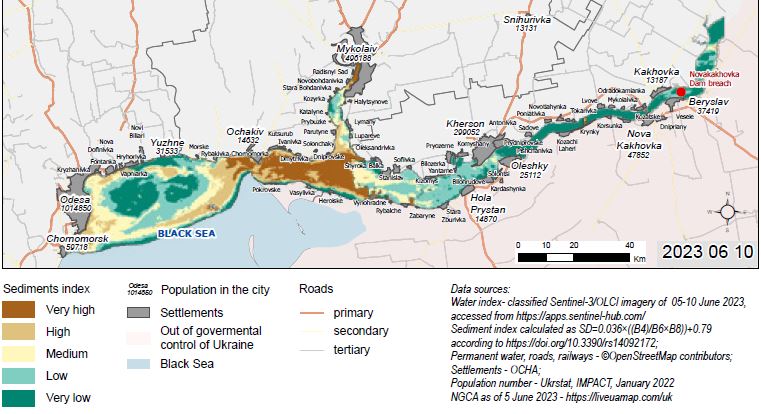
The impact of water contamination extends far beyond the Kakhovka reservoir. A satellite image analysis of sediments that spread from the Dnipro (Dnieper) River into the Black Sea shows that highly sediment-contaminated water, potentially containing sewage, chemicals, and landmine residues, spread fast over the Northern part of the Black Sea reaching Odesa and Chornomorsk. Moreover, another major river in Ukraine’s south, the Pivdennyi Buh, has also suffered, meaning that water contamination-related health concerns are not limited to Kherson Oblast but also affect the neighboring Odesa and Mykolaiv oblasts.

The contamination will lead to sea pollution. The fuel and lubricants that got into the sea water are toxic for aquatic life and can form a film on the water’s surface; moreover, the bottom sediments of the Kakhovka reservoir contained heavy metals and other pollutants from decades of emissions of industrial enterprises in the cities of Ukraine’s industrial south-east. Combined with the desalinization caused by an influx of freshwater and summer temperatures, the massive growth of algae can be expected, which deals a blow to other forms of aquatic life, writes the Ukrainian Nature Conservation Group.
2. Blow to tourism
The massive influx of contaminated freshwater into the Black Sea will create an unfavorable sanitary situation for at least a year, writes the Institute for the Future. Animal corpses, fertilizer residue, and elements of buildings and other objects will continue washing up to the shore and affecting the seawater. Moreover, mines have been dislodged by the flood. Different types of explosives – from grenades and shells to anti-tank and anti-personnel mines will present a threat for several years. Most floating river anti-landing mines will be thrown ashore within the next year. And the sunken ammunition will be washed up on the beaches for several years after each storm, the Institute notes. This greatly complicates the work of Ukraine’s tourism sector, a crucial source of income near the sea, for several years to come.
Furniture, houses and household items demolished by the waters of the Kakhovka dam wash up on the shores of Odesa Oblast
📽️ Opercommand South pic.twitter.com/Tqbwkj2hM2
— Euromaidan Press (@EuromaidanPress) June 9, 2023
3. Blow to biodiversity and ecosystems
The emptying of the Kakhovka reservoir devastated its fish population: the water body was home to at least 43 species of fish, 20 of which had industrial value (annual catches up to 2.6 tonnes per year). 7-10 years will be needed to restore these reserves, writes the Ukrainian Nature Conservation Group. Most of the fish died, either from being stranded on land because of receding water levels or from being carried to sea and perishing in its saltwater.
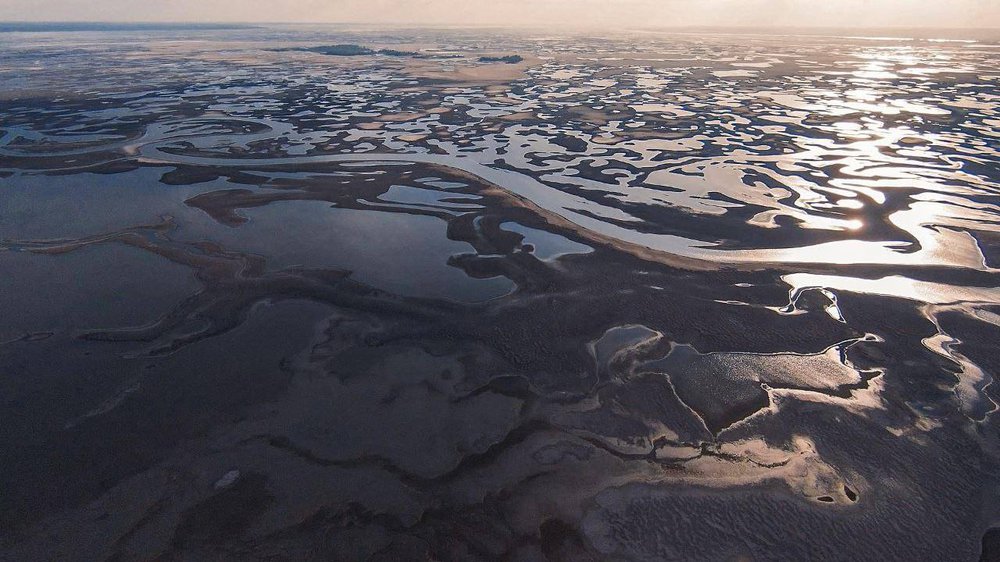
Many bird species that nested in these areas will also disappear, and the death of the invertebrates that populated the floor of the reservoir means that many fish, amphibians, and birds will lose their food base. Instead, the exposed ground, presently looking like a desert, will become home to dangerous invasive plant species, while aquatic and coastal plants of the Kakhovka Reservoir will disappear due to falling water levels. This ground is currently contaminated with heavy metals from decades of activity of industrial giants around the reservoir, and will become a biohazard for millions of people if spread by the wind. To prevent this scenario, Ukraine must urgently plant local species of grasses on what was once the bottom of the Kakhovka “sea,” says ecologist Oleksiy Vasyliuk.

However, the most damage to wildlife occurred in the flooded territories downstream, according to the group. Enormous populations of vulnerable species were wiped out overnight in a blow that the Ukrainian Nature Conservation Group believes is the most devastating to their existence in 100 years.
Particularly, 70% of the world population of Nordmann’s birch mouse was flooded, which could lead to its extinction. 50% of the population of the endangered sandy blind mole-rat, which only lives in Ukraine, was flooded.
Moreover, the gushing waters killed tens of thousands of nesting birds just rearing their young, as the floodplains of the Dnipro were home to the largest regional colonies of herons, mute swans, and other migrating birds. Endemic plants home to the sandy ecosystems were destroyed, and because the post-flood groundwater levels in this area will rise, salinization of the soil will occur. Consequently, most of the birch and oak forests here will most likely die, as will the populations of wild orchids, according to the Group.
In fact, nature reserves occupied most of the flooded territory. These include the Black Sea Biosphere Reserve, which UNESCO protects, three nature reserves, namely “Nizhnedniprovsky,” “Kamyanska Sich,” and “Biloberezhzhya Sviatoslava, the Regional Landscape Park “Kinburn Spit,” the Black Sea Biosphere Reserve including Volizhin Forest, Long Island, and Round Island with a total area of 2,700 hectares, as well as the Regional Landscape Park “Visunsko-Inhuletsky” with an area of 2,700 hectares.
3. Water shortage
Because the water levels in the Kakhovka reservoir fell, Ukraine will need to construct new water pipelines for the settlements on its banks. Ukraine’s Infrastructure Ministry has planned to construct 87 km of pipelines, including for industrial giants such as Kryvyi Rih, Nikopol, and Marganets.
Currently, these cities are living under conditions of drastic water shortages. Ukrainian authorities have set up 270 points to distribute potable water in affected communities while solutions to establish stable water supply are pursued.
But the most deficit will likely be felt by the currently occupied territories of Ukraine. According to Mykhailo Yatsiuk, director of the Institute for Water Problems, Ukraine is considering various options to supply the de-occupied part of Kherson Oblast. Various options are also being developed to provide water to the residents of the occupied parts of Zaporizhzhia and Kherson regions when they are liberated, so that they do not experience a shortage of quality water.
However, now all the regions that were dependent on the Kakhovka reservoir must switch to a water saving mode, Yatsiuk stresses. To meet their needs, Ukraine will likely need to search for groundwater reserves and local sources, conduct geological exploration.
Overall, about 700,000 people were left without water in Ukraine due to the destruction of the Kakhovka hydroelectric power plant, UN Under-Secretary-General for Humanitarian Affairs Martin Griffiths said.
But the shortage of potable water isn’t the only problem caused by the disappearance of the reservoir. Processed sewage from Zaporizhzhia, a city of over 700,000 people, will no longer be diluted and naturally restored by the reservoir’s waters. All the cities downstream of Zaporizhzhia will be affected — Kherson, Nikopol, Kryvyi Rih.
4. Blow to agriculture, rising food prices
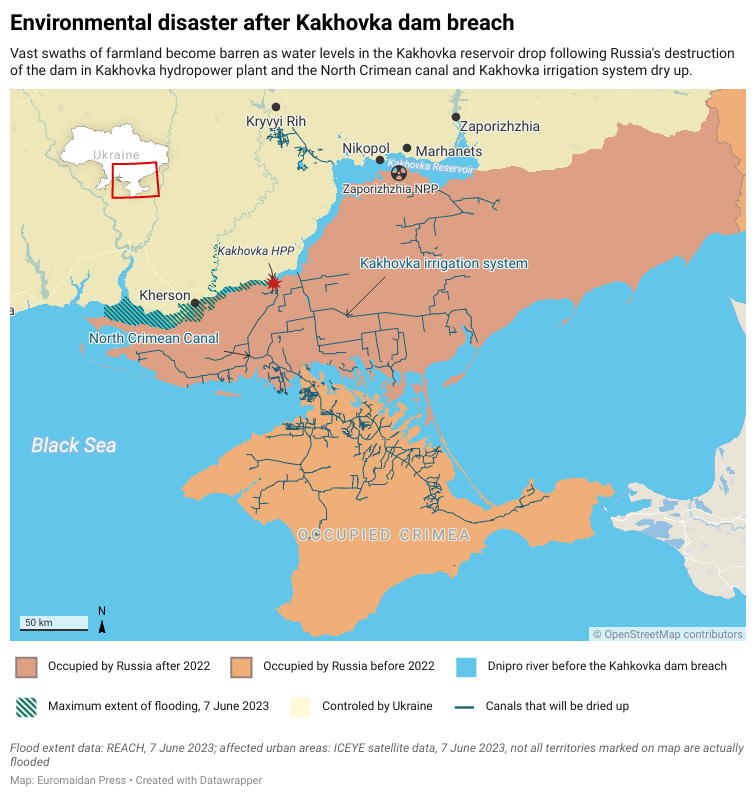
Ukraine’s Ministry of Agricultural Policy says that the explosion at the Kakhovka hydroelectric power plant will cut off the water supply to 31 irrigation systems in the Dnipro, Kherson, and Zaporizhzhia oblasts, including the vast North Crimean Canal and Kakhovka irrigation system. In 2021, these systems provided irrigation for 584,000 hectares, from which about 4 million tons of grains and oilseeds were harvested, worth about $1.5 billion.
Now, 94% of irrigation systems in Kherson, 74% in Zaporizhzhia, and 30% in Dnipropetrovsk oblasts are deprived of their water source. This may lead to the possibility that fields in southern Ukraine could turn into deserts as early as next year, the ministry says.
According to Agricultural Minister Mykola Sokalskyi, this loss of irrigation systems is the most severe consequence of the Kakhovka dam destruction for Ukraine. Lands that were not irrigated will feel the consequence, as well: farmers were able to cultivate them thanks to stable earnings from fields that received water from the canals. This means that 1-1.5 million hectares will not be used fully. Up to seven years is needed to restore the irrigation; Ukraine should make this a priority, Solskyi said.
Serhiy Khlan, a local lawmaker of Kherson Oblast, says that the losses of Ukraine’s agricultural sector are colossal: not only will the growth of export oil cultures such as sunflower, rapeseed, and soybeans be impossible, but Ukraine’s vegetable sector will suffer as well. Affordable tomatoes, peppers, eggplants, and other vegetables that were grown on the Kherson steppes will be out of reach for Ukrainians for many years. Moreover, Ukraine’s iconic Kherson watermelons, which recently received their own protected designation of origin status, can no longer be grown on the arid lands, according to the head of a local Kherson community Oleksandr Musienko, who sees the restoration of the Kakhovka reservoir as the only way to restore economic prosperity: groundwater wells cannot make up for the loss of Dnipro water, and their use will lead to soil salinization.
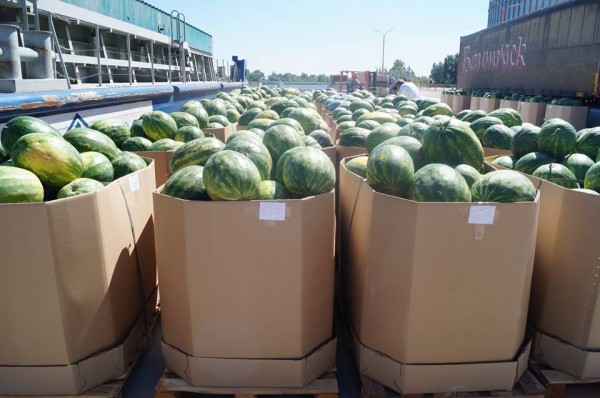
The dam’s destruction is expected to impact world food security, as well. According to the deputy of the All-Ukrainian Agrarian Council Denys Marchuk, the UN recognizes this impact, and is discussing higher food prices in the future. In the first hours after the Kakhovka hydroelectric power station was blown up, grain prices on the stock exchanges rose by about 4%, and in the future, may increase by 5-6%, Marchuk says.
5. Transport
The dam’s destruction destroyed a vital transport artery along the Dnipro, cutting off the transshipment of grain and affecting the overall throughput capacity of Ukrainian seaports. Between 2015 and 2021, Dnipro river transport increased fourfold to 14.4 million tons. Grain transshipment accounted for most of the volumes, and key agricultural holdings have created infrastructure in the form of grain terminals, river ports, and fleets, according to the Ukrainian Institute for the Future.
After February 2022, grain transportation on the Dnipro was effectively stopped. However, all the necessary structure was preserved and could be used after the war ended. There are presently no solutions to restore this key transport artery without restoring the Kakhovka reservoir.
Direct damage of Kakhovka dam destruction: over $2 billion
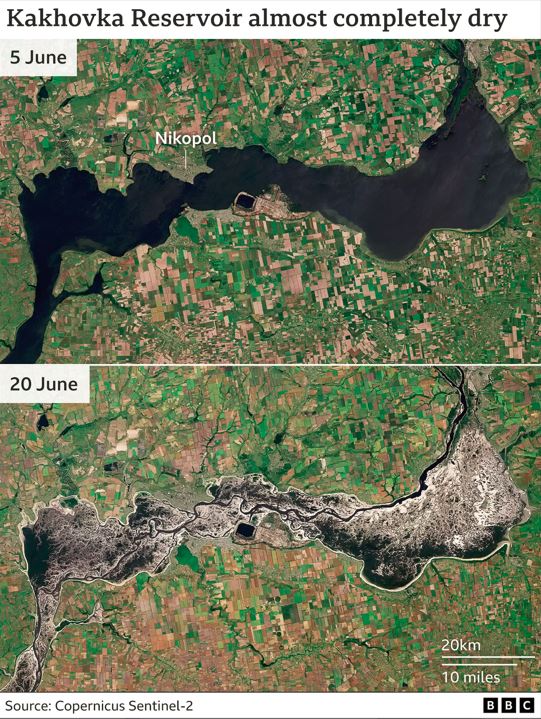
According to the Kyiv School of Economics, the direct damage caused by the destruction of the Kakhovka dam could exceed $2 billion. $950 million concerns the destruction of houses, most concentrated on the Russian-occupied east (left) bank of the Dnipro. KSE’s satellite analysis has identified 32,000 buildings that could be affected by flooding.
Ukraine will also need to build new water pipelines in four oblasts because of the drop in water levels in the emptied Kakhovka reservoir; Ukraine has already allocated $41 million for this purpose.
The destruction of the Kakhovka hydropower plant and dam are estimated to cost $624 million, and Ukraine’s state-owned Ukrhydroenergo company will lose $100 million annually because of the destruction of the power station. Damages inflicted on transport infrastructure have reached $311 million, and the industrial and business sector has suffered $105 million. Losses incurred to the crop plantations, livestock, and fish stock are relatively small, at $25 million. But indirect losses of crop production due to the disabled irrigation system are estimated at $182 annually, with other industry sectors losing up to $49 million per year.
Losses caused to the environment stand at around $1.5 billion, according to the Ministry of Environmental Protection and Natural Resources). Around 150 tons of oil leaked during the dam explosion. The salinity level of the Black Sea near Odesa is nearly three times lower than the norm.
Related:
- No, the Kakhovka dam could not have collapsed on its own
- Ukraine now probably has as many tanks as Russia
- Russia’s losses in Ukraine dwarf those of past conflicts, analyst finds
- Study shows drones the cheapest, most effective in battle against Russian invasion
- Earwitnesses recall hearing explosions on night when Nova Kakhovka dam collapsed
- Seismic signals indicate Kakhovka dam explosion – NORSAR
- Russian sabotage group blew up Kakhovka dam; it didn’t go as planned, SBU intercept alleges
- Kakhovka Dam was built to withstand nuclear strike, couldn’t be destroyed from outside – Ukrhydroproject engineering company
- Kakhovka dam breach: Hundreds of Ukrainians drown as Russia prevents evacuation, seals off flooded towns




